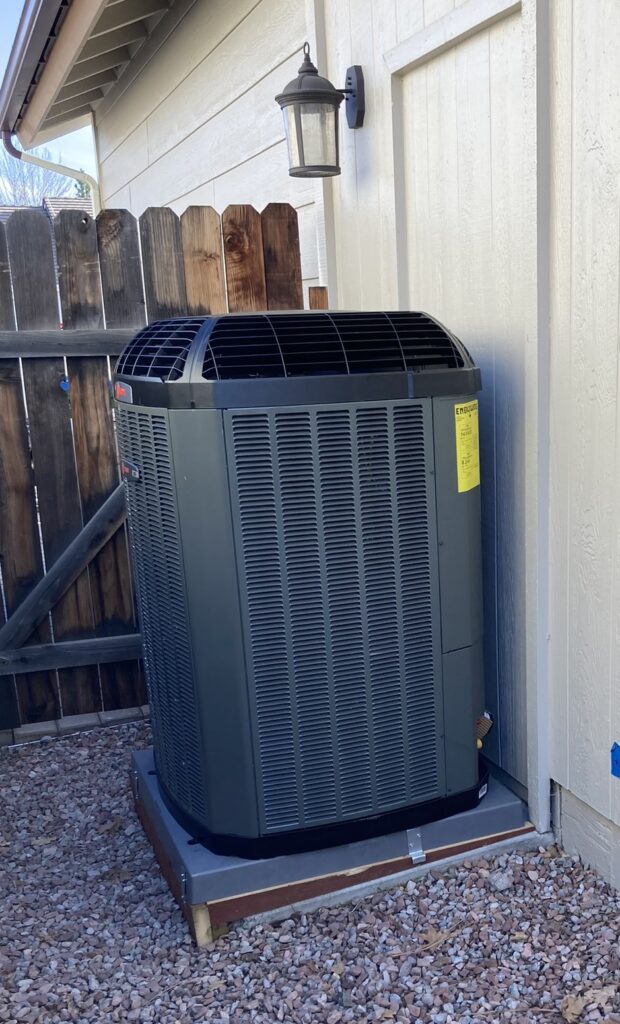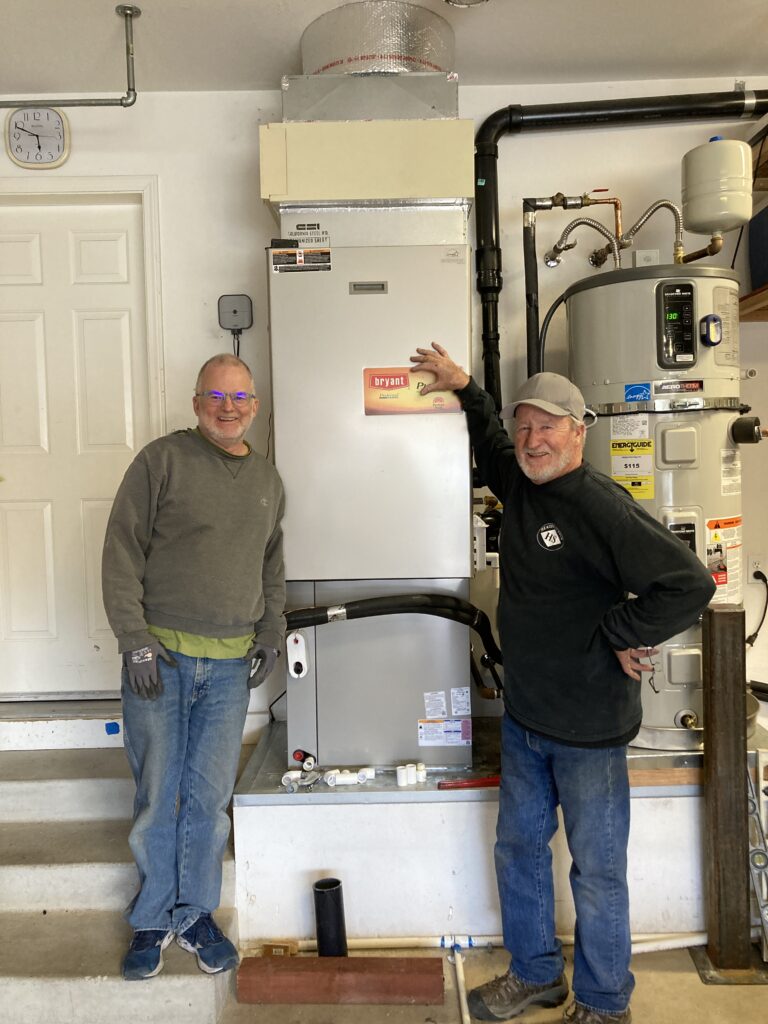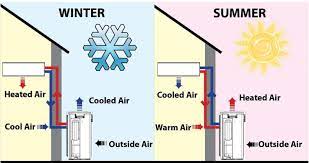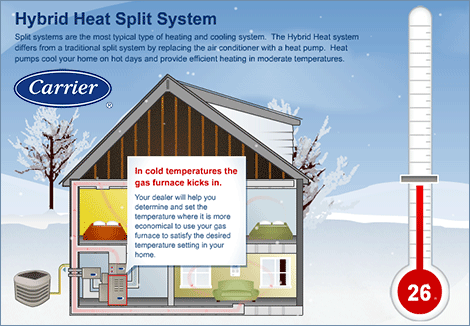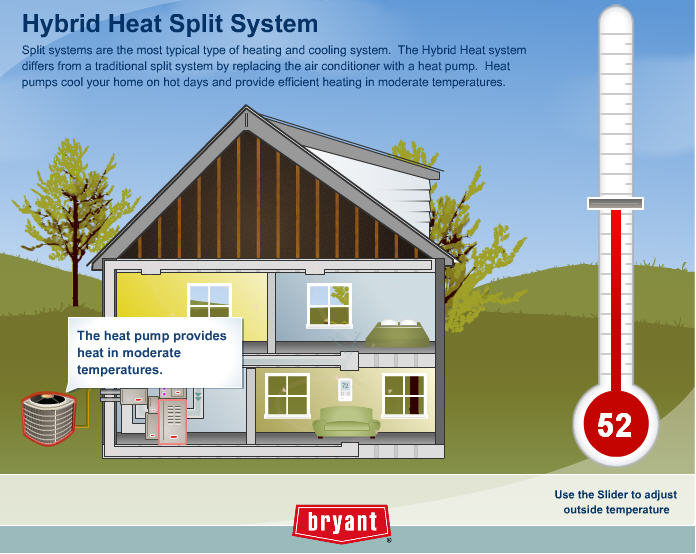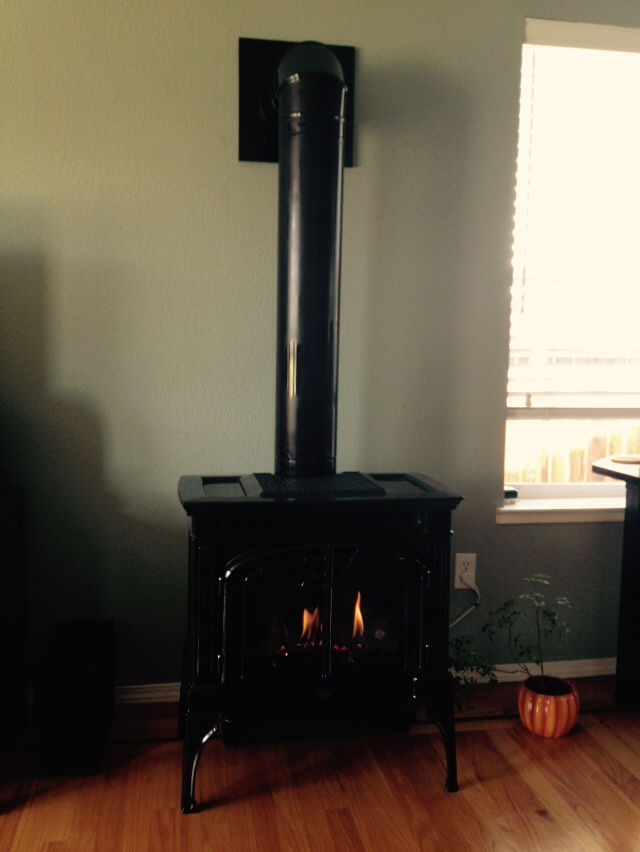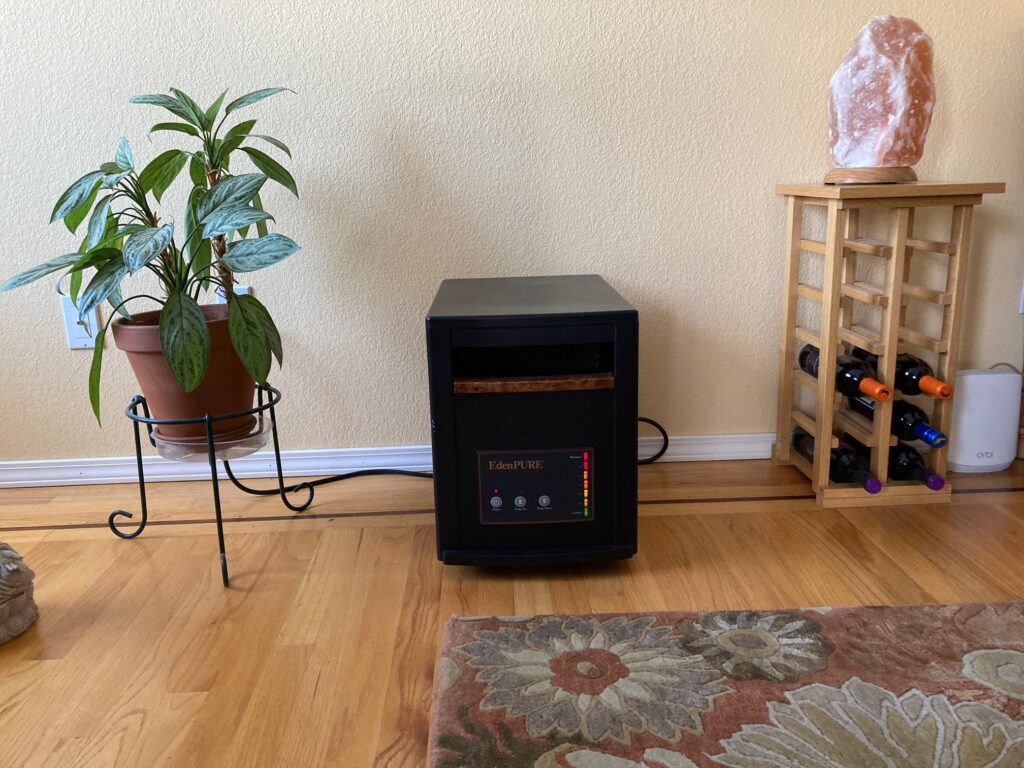Be the change that you want to see in the world. Mahatma Gandhi
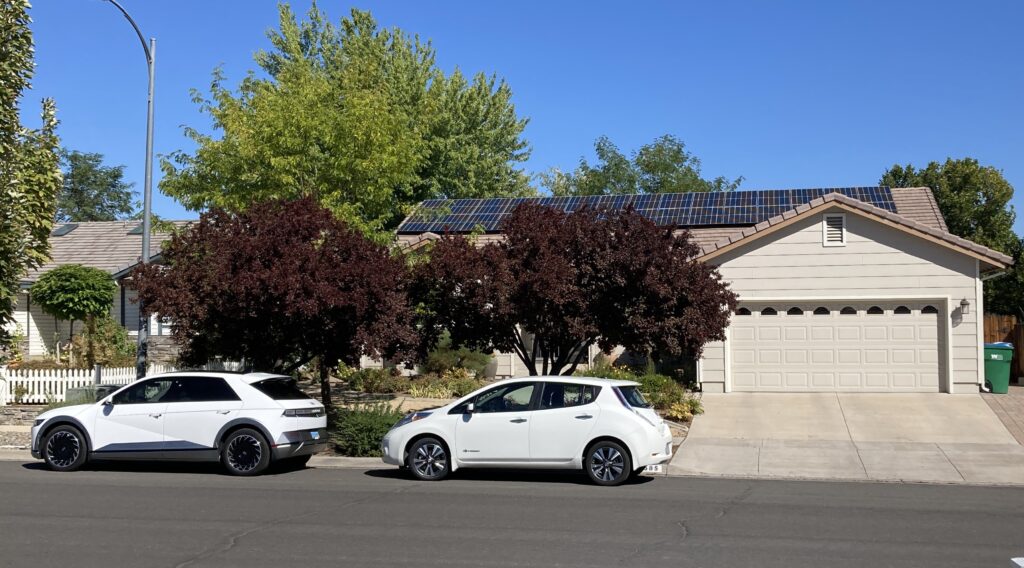
Our 30 solar panels (minus the trees shadowing them), the 2022 Ioniq 5, and the 2016 Nissan LEAF
This is truly the year it has all come together after four years of working to make our green dreams a reality. We’ve reduced our carbon footprint 41% since 2018 and are now close to our 50% goal. We are finally driving only electric vehicles, which are so fun to drive! They are fast, comfortable, good in the snow and have lots of cargo space. We are thankful we don’t have to pay for gas, given the current prices. The EV’s are like big cell phones that we simply plug in to the charger in our garage, which is part of our solar panel inverter. They make the biggest difference in reducing our carbon footprint. We have produced enough electricity with our solar panels to power our home and two EV’s, while reducing our use of natural gas by 49%. We live comfortably, keeping our indoor temperature around 70 degrees in the winter (in the rooms we use) and 77 degrees in the summer. This is aided by zone heating in winter and we will add zone A/C to our bedroom in the summer of 2023. Our heat pump water heater and hybrid heating and A/C (HVAC) systems work on programmable thermostats, similar to our old systems. But they use a lot less natural gas and are more efficient because they move heat instead of creating it–what a brilliant idea! It has been fascinating and fun to experience these new, green technologies, which work more efficiently and emit far less carbon than what we were doing before. The extra bonus is that these changes have already paid for themselves and then some! We anticipate our savings to be about $5,000 per year, which will save us $100,000 over the next 20 years that we plan to live here! AMAZING!
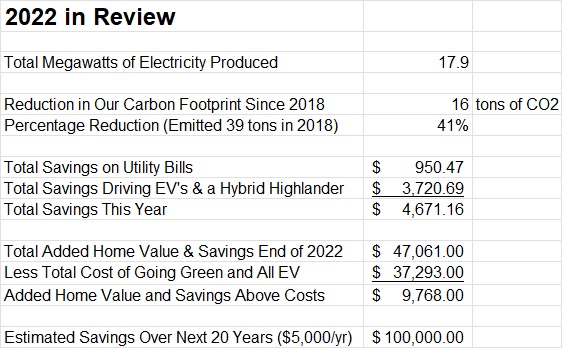
We took some leaps forward this year in our quest to reduce our carbon footprint and live in a greener home. We traded our Toyota Highlander Hybrid for a Hyundai Ioniq 5 and became an all EV household! We also love knowing that when we drive, we are emitting zero emissions into the atmosphere. We’ve done some longer road trips in the Ioniq and have found it works the same for us as a gas fueled vehicle, because we like to stop and walk every 150 miles anyway. By the time we’re done stretching our legs, our baby is juiced up and ready to roll! If you want to know more about driving EV’s, see this theme in my blog: https://rhondaashurst.com/category/driving-electric-cars/. The other goal we achieved was adding a hybrid HVAC system. This system moves warm air from outside into our home in winter and out in summer. When it needs backup (temps below 40 degrees) it uses our high efficiency natural gas furnace in the winter. This system has further reduced our use of natural gas. To learn more about it, read this post: https://rhondaashurst.com/2023/03/03/our-new-hybrid-split-heat-pump-system/.
We were shocked to see that we are already beyond the breakeven point after only four years! I had neglected to add the increase in our home value due to these green improvements, even though I’d talked about it in the first year’s blog post. Studies are now showing that green homes sell for more and faster than other homes, because buyers want to live more sustainably and they know they are purchasing a valuable stream of savings (about $5,000 per year in our case). I added a modest 6% to the value of our home and I feel confident we could get that if we sold. But we are planning to stay for another 20+ years, so I thought it would be fun to look at how much we might save over that time and was shocked to find out it would be $100,000! We will likely save even more given the way energy and gasoline prices are going up. With this kind of savings, it would be worth taking out a home improvement loan and then paying it back out of the savings, especially with the new tax breaks and incentives.
How We Did It
I always say it’s like eating potato chips, once you get started it’s hard to stop! We began by adding 22 solar panels in early 2019 to take advantage of our big south-facing roof. In 2019, we also bought a hybrid Toyota Highlander and a Nissan LEAF. We learned quickly that the cars saved the most money and carbon.
In 2020 we added an EdenPURE high efficiency zone heater and another smaller electric heater in our bedroom. Between these heaters and our Lopi natural gas stove, we reduced our gas use by around 20%!
In 2021, we shifted our main focus to reducing our carbon footprint. We added 8 more solar panels (for a total of 30), cut down some trees that were shading the panels, and added a heat pump water heater. Our panels produce about 18 megawatts of electricity per year! The heat pump water heater made a huge difference. As of this writing, the heat pump saved another 40% of gas use over what we used in 2020!
In 2022, we added a heat pump HVAC system and traded the Highlander for a Hyundai Ioniq 5, going all EV at last! Again, it was the EV that made the biggest difference in saving both carbon and money. This time we splurged on a new EV. It has all the latest features and is a blast to drive! Our strategy has been to buy one lower-end, old technology EV (the 2016 Nissan LEAF) and one higher-end, new technology EV (the 2022 Hyundai Ioniq 5). We use the LEAF for our in-town driving and the Ioniq for road trips. This combo works great and between the two, they cost only $13,700 more than their comparable ICE’s. I estimate they will save us $3,500/year to drive over those ICE’s, so will pay for themselves in four years. We don’t yet have enough data to know how well our heat pump HVAC is doing; we hope to have a good idea by summer.
In 2023, we plan to add a mini-split heat pump to our bedroom for zone cooling (and perhaps some heating). We’d like to keep our room cooler for sleeping in the summer, but leave the rest of the house in the 80’s. We’re hoping with this change, we will reduce our use of electricity and hopefully be able to generate all our required electricity off our panels. Plus, it’ll give us a chance to try out a mini-split! We’re curious about how it operates vs. our ducted heat pump HVAC.
In our case, this has been a long-term project where we look at the synergy between all the systems. They work together to save more money and carbon than they would by themselves. We are also lucky to live in NV with tons of sun and a big south-facing roof. Our house has extra insulation, double pane windows, and an attic fan which helps hold the temperature inside. Over time we have also switched to LED lighting; it especially helped to change out our old outdoor Christmas lights to LED’s.
For more details, see the blog posts from each year under this theme: https://rhondaashurst.com/category/going-solar/.
Thinking About Trying It Yourself?
We’d recommend you start with solar panels and increasing the efficiency of your home (insulation, windows, sealing cracks, attic fan, etc). The next thing to add would be an EV or two, as they will save you the most money and carbon. After that, the heat pump water heater is a great gas saver and super efficient. If you have electricity left over, then think about heat pump HVAC.
If you don’t have solar panels, electricity is more expensive than natural gas, but not as expensive as gasoline. So, an EV can be worth it, but the other systems might not be. If your electrical grid is mostly powered by fossil fuels (which most are), you are still burning carbon to run the systems. In many states, you can purchase renewable energy from your power company or you can buy “green tags”, see this site for more information: https://www.energy.gov/energysaver/articles/easy-way-use-renewables-buy-clean-electricity
Summary of 2022

This table has more detail on savings of both carbon and money, plus more cost detail. It also shows the history of the changes we’ve made since 2018 and how it builds over time.
Bottom Line: We’ve saved 52 tons of carbon from entering our atmosphere, while saving money (past breakeven after 4 years), increasing the value of our home and enjoying the pleasure of driving really fun EV’s!
NOTE: The heat pump systems were purchased at wholesale and installed by Scott, his brother and friends. This significantly reduced our costs. In the table, we are only looking at the additional costs of replacing our old units with heat pumps vs. older technology.
THE DATA FOR MY FELLOW NERDS:
The Quest to Reduce Our Carbon Footprint

Last year we began a new quest to reduce out carbon footprint. We are excited to see that we have reduced our carbon footprint by 41% since 2018! This year we used a new, more accurate carbon calculator on the Nature Conservancy’s site. Here’s the link if you want to try it yourself: https://www.nature.org/en-us/get-involved/how-to-help/carbon-footprint-calculator/. This calculator uses US data, while last year’s used UK data. It is best if you use a calculator that is based on your country’s carbon data.
According to the latest report by the Intergovernmental Panel on Climate Change, we have a limited time to reduce global greenhouse gas emissions before we reach a point of no return. They are asking us to cut our emissions 50% by 2030. When all of us do what we can, we create a tidal wave of change! What we have learned during this journey is that we can drastically reduce our carbon footprint without sacrificing a comfortable, modern lifestyle. There are great technologies out there to help like solar panels, electric vehicles, and heat pump systems which allow us to cut our emissions significantly. It is actually not that difficult to replace old systems with these technologies and it makes such a difference. It’s also easy to install these more efficient systems in newer homes. In Nevada we are lucky to have this amazing sun and a net metering power company that allows us to bank and use our excess solar energy. Did you know that the biggest part of our carbon footprint comes from the energy we use in our homes and vehicles?
Electricity Production and Accumulated Credits
Our Online SolarEdge Panel. Click to see what we are producing with our rooftop solar array!
Our gratitude to Travis and the guys at Great Basin Solar (https://www.greatbasinsolar.com/) for the awesome job they did designing and installing our system.
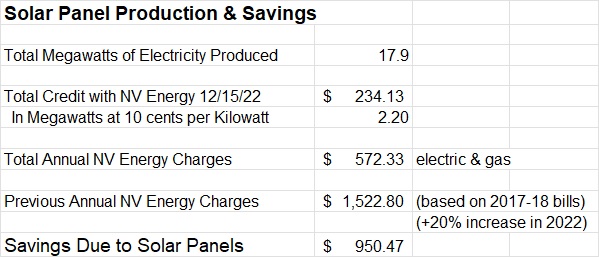
We produced 17.9 megawatts, 4.7 megawatts more than last year! We were thrilled to see what a difference it made to install 8 new panels in 2021 and take out the trees that had been shading some of the panels. We are hopeful that we can now produce enough electricity to power our EV’s and our home with the addition of the heat pump systems.
Our banked power with NV Energy went from 2.0 to 2.2 megawatts, so we have a little extra going into 2023. Both electricity and gas prices went up significantly in 2022, so we are now using our banked credits at a higher rate. It will be interesting to see how this all turns out next year…
Because of the increase in utility bills, we added 20% to our previous annual charges to account for inflation. With the reduction in our use of natural gas, we saved a $950.47 on our utility bills this year!
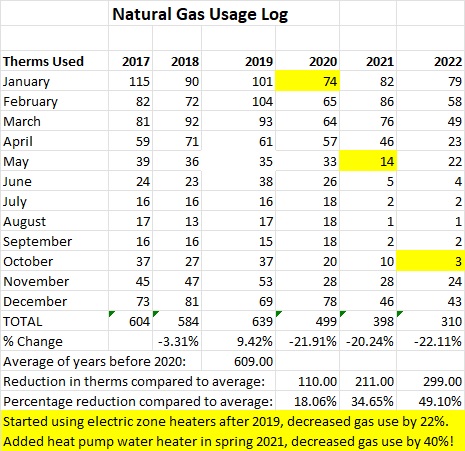
Now we are using 49% less gas than we did before.
We also saved 3600 pounds of carbon!
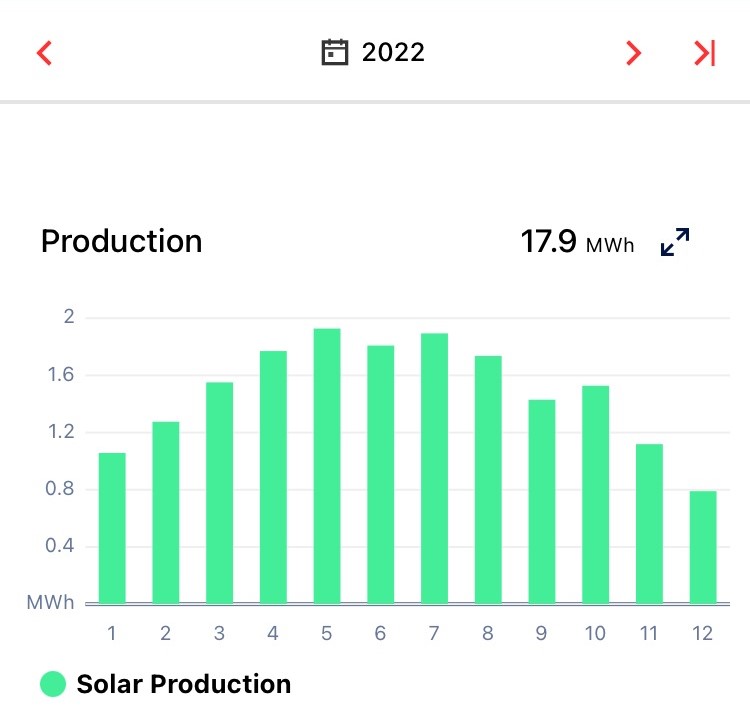
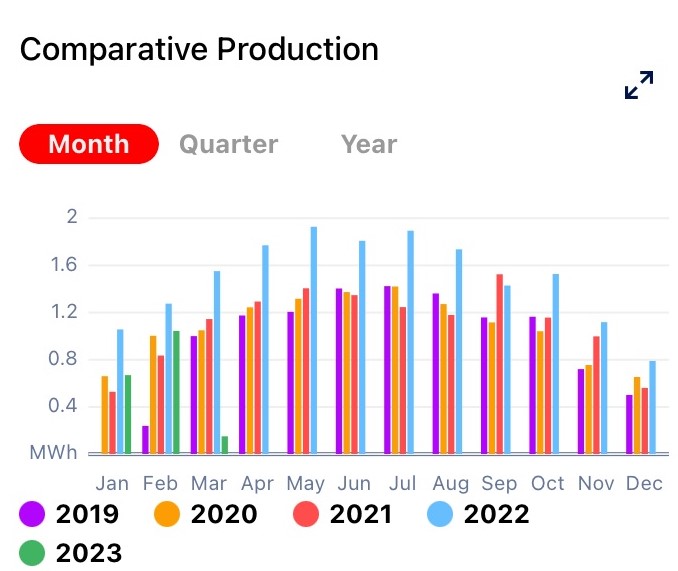
These are the graphs from our SolarEdge inverter showing the production of electricity off our roof. You can see that our lowest production months are November-February, which is when we are using the electric zone heaters and running Christmas lights. It’s during these months that we tap into our banked power with NV Energy. In the higher production months, we send more power into the grid, which is used by other households and increases our banked power.
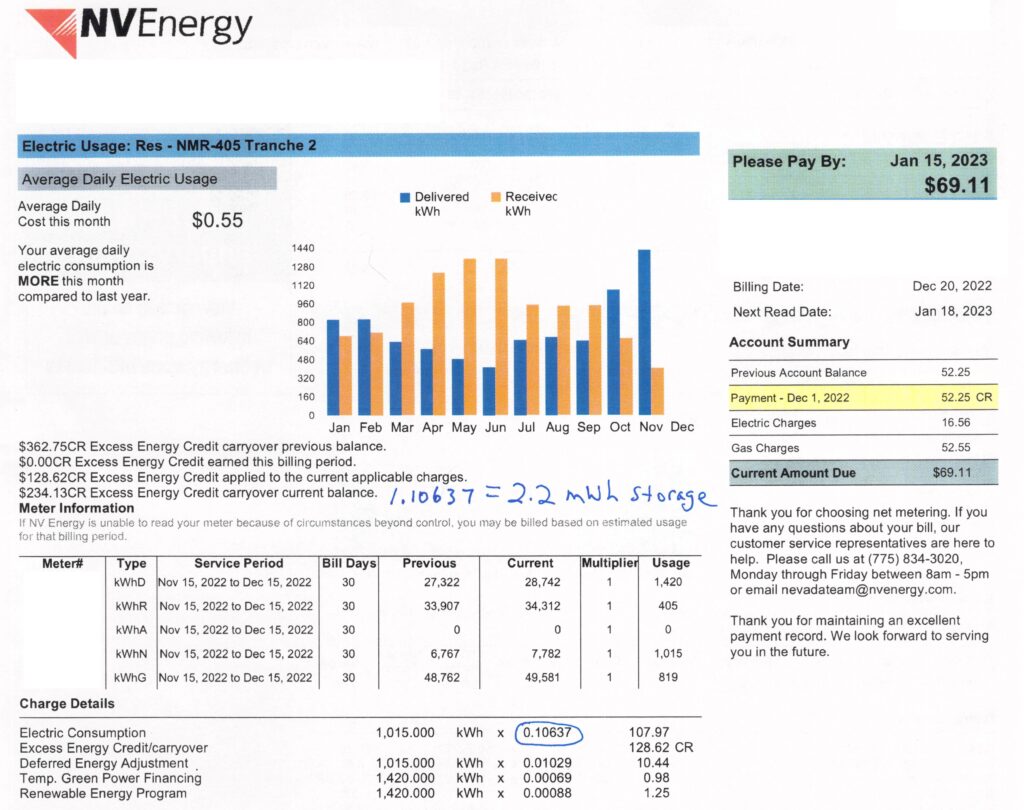
Hand calculation is of our stored bank of 2.2 megawatts
(Bank of $234.13 divided by price per kilowatt of .10637)
THE EV’s
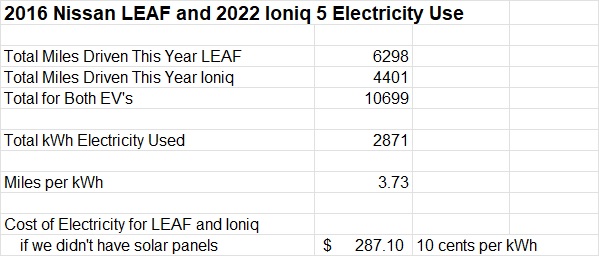
This table shows the miles we drove in our EV’s (about 5.5 months in the Ioniq), the electricity we used and the miles per kWh. It’s interesting that we get about the same mileage on both our EV’s. If we had to pay for this electricity, it would have only cost $287 to power them. The next two tables show what it would have cost to drive the comparable gas cars–about $2100! The gas prices went up from an average of $4/gallon in 2021 to over $5/gallon in 2022. This really increased our savings in 2022, plus driving a second EV.
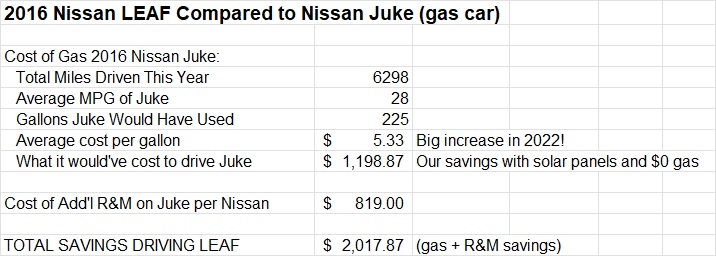
We were shocked when we asked our Nissan Tech how much it would have cost to do the 45,000 mile service on a Juke and he said an additional over $800! Ouch! We are definitely at the stage with our LEAF where there are big savings in the repairs and maintenance. The LEAF has become Scott’s ride (it’s amazing what he can fit in that car!). At over 45,000 miles and 7 years old, it still has a range of 85 miles when charged to 100%. This is only a loss of 25 miles or about 23% of what it could do originally. We are down to 7 out of 10 bars on our battery. The LEAF still has plenty of range for around town trips and has had no major mechanical or electrical issues.
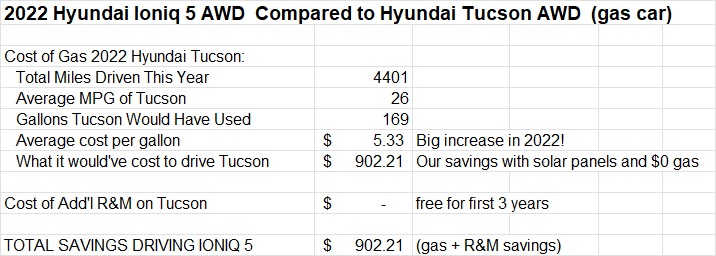
The Ioniq is my ride and I LOVE her! Most awesome car I’ve ever driven! (You can read more in the Driving EV’s theme.) She is our road car, so we anticipate we will put more miles on her than our LEAF. So far road tripping has been comfortable and easy. We’ve been able to find chargers whenever we need them. We get two free years from Hyundai at Electrify America, so for now our charging on the road is free! The other thing we love about Electrify America is their power comes from renewable sources. It will be interesting to see how much we save driving the Ioniq for a whole year. We got her in July 2022, so this is only a little over 5 months of driving.
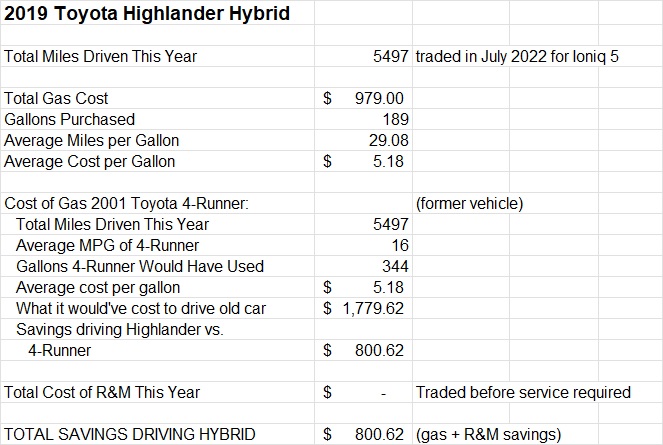
We said farewell to our Highlander when we traded her for the Ioniq in July. It was an awesome car when we needed a V-6 to tow Pearl. In July we also sold Pearl, our cute little teardrop trailer. If you’re in the market for a large SUV hybrid, the Highlander is a great choice and saved us a lot of money over our old 4-Runner. The above table shows the $800 we saved driving the Highlander for 1/2 a year.
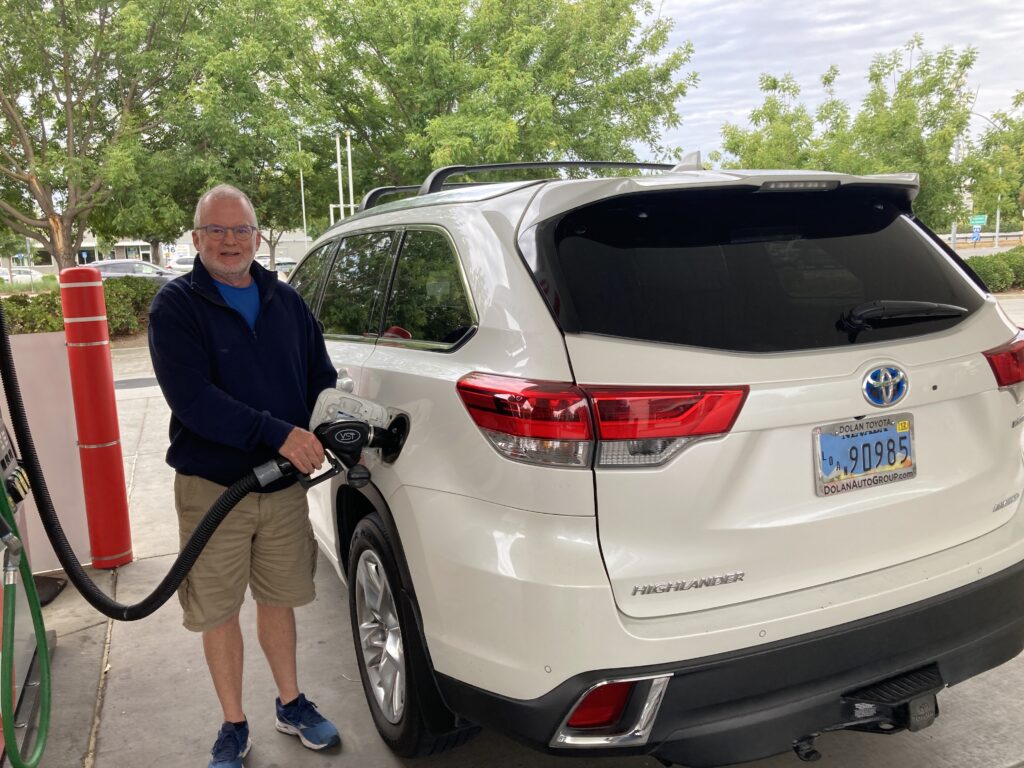
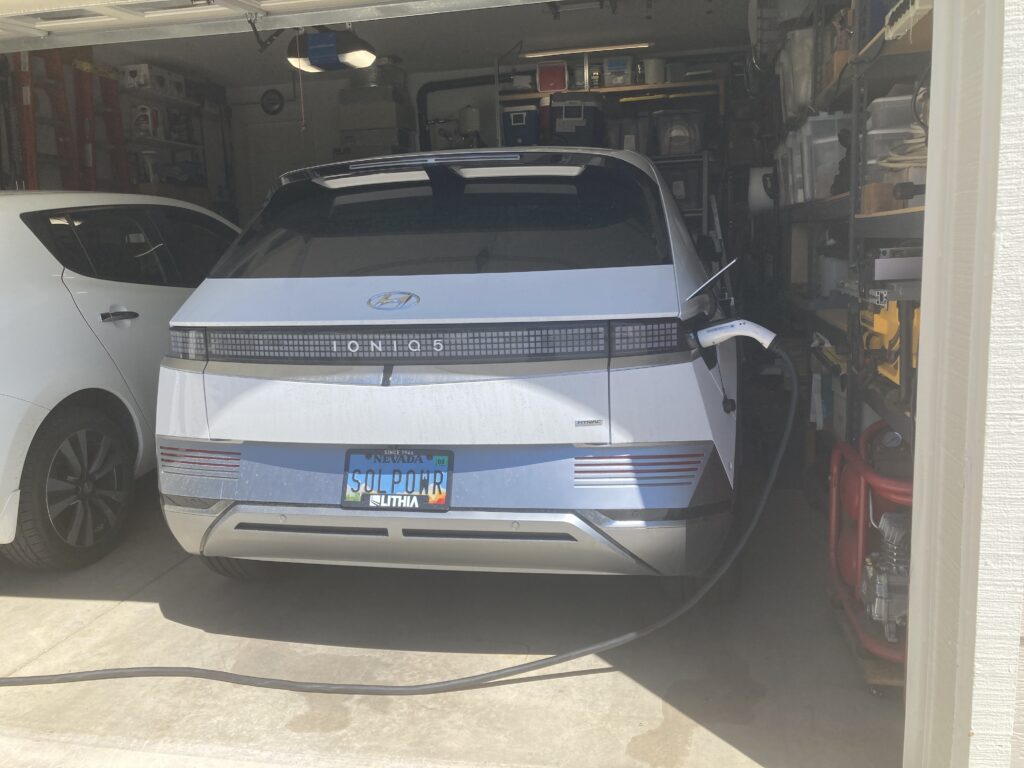
EV’s powered by solar are one of the best ways to reduce both your transportation cost and carbon footprint. We recommend get solar and get EV’s–it’s worth it! If you don’t feel comfortable going all EV, plug-in hybrids are a next best choice, followed by regular hybrids. All these vehicles will save you money, while helping the environment. EV’s and plug-in hybrids assembled mostly in the USA are eligible for a $7,500 tax rebate when purchased new. Used EV’s can qualify for up to $4,000 in tax rebates as well. We like having one newer model and one older, used model. These cars cost $13,700 over their comparable gas cars. I estimate they will save us $3,500/year in gas and R&M. So we’d break even on the extra expense of buying the EV’s in 4 years.
If you made it this far, I’m impressed! Stay tuned for updates on driving EV’s, life with heat pumps, and the next adventure of installing and using a mini-split. See if we can actually meet all of our electricity needs off our roof. Yesterday I learned that Tesla is opening up its supercharging network to those of us who don’t own Teslas. We’re looking forward to trying that out and will let you know how it goes!

